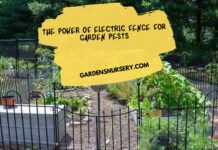The Ultimate Guide To Defending Your Plants Against Common Pests
Caring for plants is a rewarding task that requires patience and knowledge. Unfortunately, even the most meticulous gardener can experience problems with pests.
With a wide range of threats, from aphids to Japanese beetles, your plants can fall prey to various pests that can hinder growth and potentially damage them beyond repair. But don’t worry! This guide covers all you need to know to defend your plants against these pests.
-
Identifying The Culprit
Knowledge is power, and identifying the culprit is the first step towards solving a pest problem. There’s a host of common pests that love to munch on plants – aphids, scale insects, spider mites, and Japanese beetles, to name a few.
Each of these pests has unique characteristics and damage patterns. For example, aphids are tiny, soft-bodied insects that suck the sap out of plants, causing leaves to wilt and discolor.
On the other hand, Japanese beetles are larger, hard-shelled insects that eat holes in plant leaves, flowers, and fruits. Identifying the pest allows you to tailor your pest control strategies accordingly.
-
Creating A Barrier
Once you’ve identified the problem pest, it’s time to devise your defense strategy. A vital part of plant defense involves preventing pests from accessing your plants in the first place. This is what the barrier method aims to achieve. A well-designed barrier can deter a wide range of pests, such as snails, caterpillars, and other flying insects.
Several common barrier methods include:
- Garden Netting: Lightweight and versatile, garden netting can protect your plants from a range of pests. This barrier allows light and rain to permeate while keeping insects at bay.
- Row Covers: These are fabric covers that you drape over plants. Row covers are particularly effective for keeping out beetles and moths, but they also offer protection from harsh weather conditions.
- Copper Tape: Slugs and snails dislike crawling over copper, making copper tape a simple and effective barrier against these pests. You can wrap it around the base of your plants or pots to deter these slimy invaders.
In essence, creating a barrier is a proactive, non-chemical way to protect your plants from pests. With appropriate materials, correct installation, and regular maintenance, you can stop pests before they reach your plants.
-
Utilizing Companion Planting
Companion planting is one of the natural repellents you can consider. It’s the idea that certain plants, when grown together, can enhance each other’s growth, repel pests, or offer additional benefits.
To make the most out of this technique, you need to understand which plants benefit one another. For example, tomatoes and basil are known companions. The strong scent of basil can deter pests that typically bother tomatoes.
Once you know the beneficial pairings, consider planting such species together in close proximity. Do it in the same pot or planter for smaller plants or side by side in a garden bed for larger ones.
However, ensure to take the size and growth habits of every plant. You don’t want larger plants overshadowing the smaller ones, blocking their sunlight. So, plan your garden layout carefully.
Companion planting is not rocket science. But what works in one garden might not work in another. Try different combinations to see what works best for your specific situation. When done effectively, you can create a dynamic, healthy garden that looks beautiful.
-
Using Insecticidal Soap And Sprays
Another effective method to protect your plants is using insecticidal soap or sprays. These products often work by suffocating pests or disrupting their life cycles. Here’s how to use them effectively:
-
Select The Right Product
Start by identifying your pest. Since different products target various pests, choose a product effective against your specific problem. Insecticidal soaps, for instance, are ideal for soft-bodied insects like aphids and mites.
-
Apply The Product
Apply the product directly to the plan, ensuring you cover all surfaces. The pest needs to come into direct contact with the product for it to work. Pay special attention to the undersides of leaves, a favorite hiding spot for many pests.
-
Timing Is Key
Insecticidal soaps and sprays are most effective when pests are in their early stages of development. Regular applications may be necessary to ensure you’re targeting the pest at the right time.
-
Follow The Instructions
Always follow the manufacturer’s instructions. Some products need to be diluted before use. Others may be harmful to certain plants and beneficial insects like bees and ladybugs.
-
Monitor Your Plants
After applying the product, keep an eye on your plants. Watch for signs of improvement, but also for any potential harm. If you notice any adverse reactions, stop using the product and consult a gardening professional.
This method is a practical way to deal with pests on a plant-by-plant basis, and can also be used in conjunction with other methods for a more comprehensive pest defense strategy.
-
Encouraging Natural Predators
Mother Nature provides some of the best defenses. Many pests have natural predators that keep their populations in check. By attracting these natural predators to your garden, you can maintain a healthy ecosystem and help keep pest populations in control. Here’s how:
-
Attract Birds
Many bird species feast on pests like beetles, caterpillars, and slugs. To make your garden more bird-friendly, consider installing a birdhouse or feeder. Bird baths are also attractive, as they provide a water source for your feathered friends.
-
Invite Ladybugs
These charming beetles are a gardener’s best friend. Ladybugs, particularly their larvae, are voracious predators of aphids, mites, and other harmful insects. You can attract them by planting herbs such as dill and fennel or flowers like marigolds and geraniums.
-
Welcome Spiders
Although they might not be everyone’s creatures, spiders are exceptional pest controllers. They feed on various pests, such as mosquitoes, flies, and aphids. By providing sheltered spots like rockeries or log piles, you may encourage spiders to inhabit your garden.
Encouraging natural predators lets you manage pests eco-friendly and contribute to a balanced garden ecosystem.
-
Rotating Crops
This may sound like a farming term, but it’s relevant for home gardeners too. Crop rotation involves changing where you plant different types of plants each year. This practice confuses pests and interrupts their life cycle, making it harder for them to establish a permanent presence in your garden.
Rotating crops allows the soil to naturally replenish the nutrients used by the previous plant. This keeps your soil healthy and reduces pests attracted to weak, undernourished plants. Furthermore, it helps reduce the chance of diseases lingering in the soil and infecting the next year’s plants.
So, how can you practice crop rotation at home? It’s easier than you might think. Here are a few tips:
- Start by creating a map of your garden as it is now, noting what’s planted where.
- Once you have your garden map, plan what you’ll plant next year. The key is to make sure you don’t plant the same type of plant in the same spot two years in a row.
- It’s easier to rotate crops if you group similar plants together. For instance, plant all your brassicas (like cabbage and broccoli) in one area, your legumes (like peas and beans) in another, and so on.
- Different gardeners follow various rotation schedules, but a common one is a three or four-year rotation. This means you won’t plant the same type of plant in the same spot for at least three or four years.
By integrating crop rotation into your gardening practices, you can strengthen your defense against pests, improve soil health, and even combat plant diseases. It’s a win-win all around.
-
Practicing Good Hygiene
Maintaining a clean and tidy garden is critical to preventing pest infestations. Common garden pests are often attracted to debris and clutter, which can provide them with shelter and food sources. By practicing good hygiene in your garden, you can create an environment that’s less appealing to pests. Here’s how you can maintain hygiene in your garden:
-
Clean Regularly
Regular cleaning of your garden can help prevent pests from settling in. This involves removing fallen leaves, twigs, and any other plant debris that might accumulate on the ground. Not only does this eliminate potential hiding spots for pests, but it also helps prevent the growth of fungi and bacteria that could harm your plants.
-
Remove Infected Plants Promptly
If a plant in your garden appears infected with pests or diseases, remove it promptly to avoid the spread to healthy plants.
-
Sanitize Garden Tools
Garden tools can sometimes carry pests or diseases from one plant to another. To prevent this, make sure to clean and sanitize your tools regularly. This can be as simple as washing them with soap and water. For a more thorough clean, soak them in a solution of bleach and water.
Maintaining these hygiene practices makes your garden less attractive to pests and promotes plant health. Remember, a clean garden is a happy garden!
Conclusion
While pests are a common concern for gardeners worldwide, it’s essential to understand that there’s no one-size-fits-all solution for safeguarding your plants. Each method has strengths and weaknesses, so a combination of methods may be necessary for an effective plant defense strategy. However, armed with patience, knowledge, and some trial and error, you can create a robust, pest-free garden.
Read More: How to Safeguard Your Garden and Home from Invasive Pests











